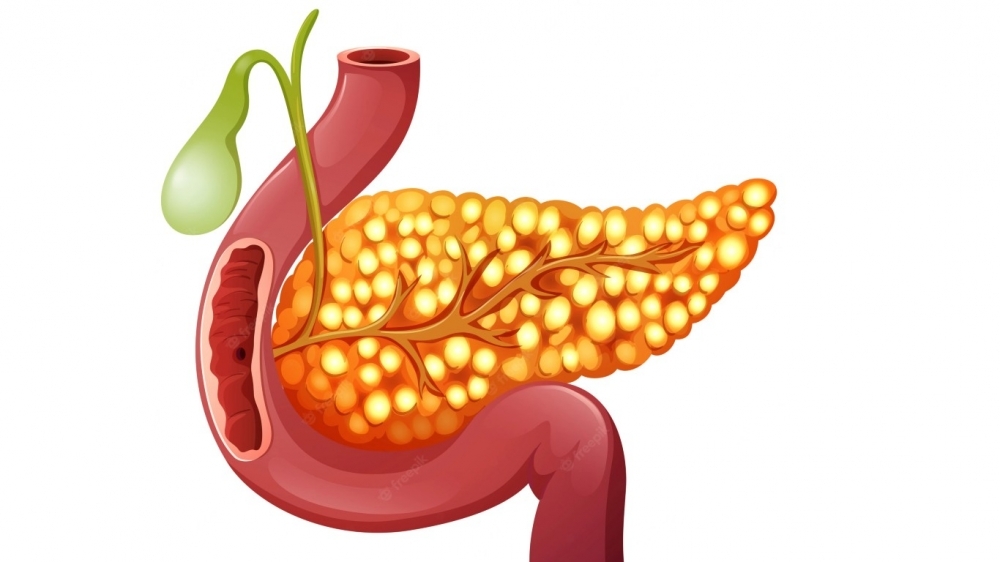

Researchers at the University of São Paulo analyzed the expression of long non-coding RNAs, the type that does not give rise to proteins, in samples from patients and tumor cell lines, identifying a group of genes with augmented expression in pancreatic cancer (image: brgfx/Freepik)
Researchers at the University of São Paulo analyzed the expression of long non-coding RNAs, the type that does not give rise to proteins, in samples from patients and tumor cell lines, identifying a group of genes with augmented expression in pancreatic cancer.
Researchers at the University of São Paulo analyzed the expression of long non-coding RNAs, the type that does not give rise to proteins, in samples from patients and tumor cell lines, identifying a group of genes with augmented expression in pancreatic cancer.

Researchers at the University of São Paulo analyzed the expression of long non-coding RNAs, the type that does not give rise to proteins, in samples from patients and tumor cell lines, identifying a group of genes with augmented expression in pancreatic cancer (image: brgfx/Freepik)
By Julia Moióli | Agência FAPESP – Among the many discoveries that have resulted from the Human Genome Project completed in 2003 is the knowledge that a large proportion of our genes do not generate RNAs that encode proteins. Only 5% have this function, in fact. Non-coding genes were once disparagingly referred to as “junk DNA”. For two decades, they were ignored in cancer research, for example, and scientists focused on messenger RNAs, which carry the instructions for making proteins, as targets for therapy. The certainty that non-coding genes have important functions is now more widespread, however. A case in point can be found in an article published recently in Cellular Oncology. According to the authors, long non-coding RNAs (lncRNAs) appear to play a role in pancreatic cancer.
The study was supported by FAPESP (projects 13/13844-2, 13/13350-0, 14/03943-6, and 19/04420-0) and was performed by a multidisciplinary team of biochemists, molecular and cellular biologists, bioinformaticians and physicians who analyzed a set of lncRNAs in pancreatic tumor cell lines, using specific tools in the laboratory to manipulate gene expression by the cells. The results confirmed that the lncRNAs were oncogenic, as expression of the genes favored tumor formation.
“We found that when the lncRNAs were silenced, characteristics of the tumor cell were reduced, making it less aggressive and malignant because it proliferated, migrated and invaded less, and carried out less DNA repair,” said Eduardo M. Reis, a professor in the Biochemistry Department of the University of São Paulo’s Institute of Chemistry (IQ-USP) in Brazil.
According to Reis, the results increase scientists’ understanding of pancreatic cancer, which is lethal and hard to treat, although its incidence is lower than that of other types of cancer. “Since the start of research in molecular biology using next-generation sequencing tools to identify new markers, better treatments have been developed for several types of cancer, such as breast, lung and prostate cancer, with a very positive effect on survival rates. Unfortunately, this isn’t the case for pancreatic cancer,” he said.
The next step is to manipulate and silence these lncRNAs using in vivo tumor models, where fragments of tumors from patients are implanted and maintained in mice (xenotumors), with the aim of finding out whether tumor aggressiveness can in fact be reduced in practice.
In parallel, Reis and his team are analyzing single-cell RNA sequencing databases to obtain the transcriptome (all RNA transcripts) for each of the cells in a tissue sample, instead of analyzing the tissue as a whole. They also aim to investigate the activity of lncRNAs in the different cell types that make up the tumor microenvironment so as to understand their functions and possible use as biomarkers.
Bioinformatics
Besides the specific knowledge gleaned regarding pancreatic cancer, the study led by Reis contributes a strategy for investigating the action mechanism of non-coding RNAs. Their numbers are known to increase in tumors, and they affect cells when manipulated, but exactly how this happens is unclear. The functions of messenger RNAs can be predicted from the proteins encoded in their sequences, but this is not yet possible for lncRNAs.
“It’s more or less like the Egyptian hieroglyphs found by archeologists. Initially, they were an absolutely unknown language and couldn’t be translated without the Rosetta Stone. We don’t have the code that translates the information contained in the primary sequence of these lncRNAs into a three-dimensional structure with specific functions,” Reis said.
To surmount this limitation, the researchers used a bioinformatics approach to analyze the activity of the lncRNAs in the context of a gene co-expression network also comprising protein-encoding genes whose functions are known. Comparing samples of tumor and non-tumor tissue, they concluded that several lncRNAs displayed a similar co-expression pattern to protein-encoding genes with important functions in the context of cancer and that their activity might therefore be the same, or subject to the same regulation.
More specifically, the lncRNA UCA1 was found to be necessary for DNA repair in tumor cells exposed to ionizing radiation. In other words, expression of this non-coding RNA appears to help tumors recover from the damage caused by radiation therapy.
According to Reis, the study surveys the possible molecular functions of oncogenic lncRNAs, pointing to avenues for further research on the functions of lncRNAs in pancreatic cancer and development of novel therapies.
The article “Annotation and functional characterization of long noncoding RNAs deregulated in pancreatic adenocarcinoma” is at: link.springer.com/article/10.1007/s13402-022-00678-5.
Image of brgfx on Freepik
Republish
The Agency FAPESP licenses news via Creative Commons (CC-BY-NC-ND) so that they can be republished free of charge and in a simple way by other digital or printed vehicles. Agência FAPESP must be credited as the source of the content being republished and the name of the reporter (if any) must be attributed. Using the HMTL button below allows compliance with these rules, detailed in Digital Republishing Policy FAPESP.




